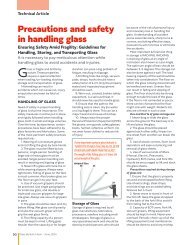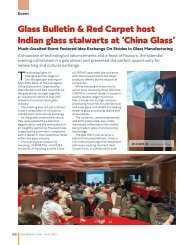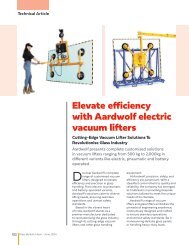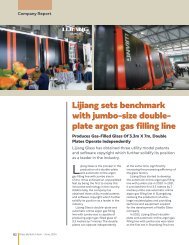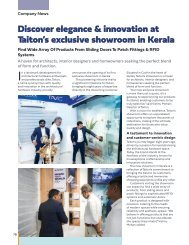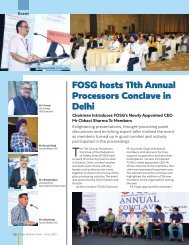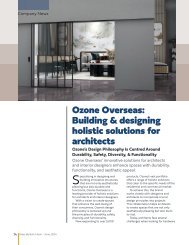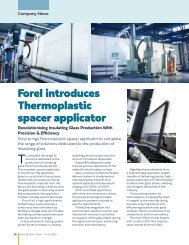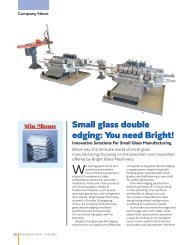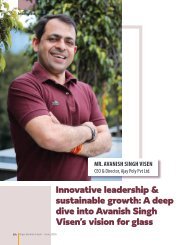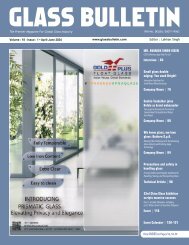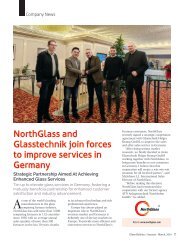Edition 57 (Jan-Mar, 2020)
You also want an ePaper? Increase the reach of your titles
YUMPU automatically turns print PDFs into web optimized ePapers that Google loves.
Coherent • 2
contaminated water).
Finally, mechanical glass cutting
can’t be easily applied to cutting of
curved shapes or glass parts with
complex 3D shapes. And, both of these
capabilities are increasingly required,
especially for displays and touch
panels on automobiles, appliances, and
handheld electronics.
SmartCleave (the most effective
form of filamentation cutting) is a
sophisticated glass cutting process,
developed by Coherent which utilizes a
laser which produces ultra-short pulses
(< 15 picoseconds or trillionths of a
second).
The very high focused laser power
which is obtainable from this type
of source can be applied in such a
spatially precise and limited manner
that there is no bulk heating of the
glass, and therefore, no thermal
damage to the material.
The result is an extremely smooth
edge, with no burrs, less cracks or
breakouts, minimal edge stress, and
completely eliminates the need for
subsequent processing. Thus, all the
additional grinding, washing, and
drying steps, along with their energy
consumption, time, cost and negative
environmental impact, are absent.
SmartCleave increases yields, improves
quality, and lowers production costs.
Plus, SmartCleave allows high-speed
cutting of tight curves, without taper,
and can be utilized to cut 3D shapes.
A Cooperative Research
Project
The OptiGLas research project was
initiated in 2015 by Flabeg, a company
which continually strives to improve
their product quality and reduce
manufacturing costs by employing
the latest technology. Flabeg wanted
to explore the SmartCleave laser
cutting method instead of mechanical
separation and extend further its
utility. In particular, the consortium
identified several specific areas of
exploration.
The first was to investigate how
SmartCleave parameters must be
varied for use with different materials,
in this particular case soda lime
glass (in two different thicknesses),
The SmartCleave process is accomplished using a sub-system comprising the ultrashort pulse HyperRapid NX laser and beam scanning
and focusing optics.
aluminosilicate glass, borosilicate
glass, and glass ceramics. Of particular
interest was borosilicate glass because
it is proven among the experts to
be the most challenging material to
separate.
Second, SmartCleave was originally
developed primarily for cutting thin
glass for touchscreen displays. Flabeg
and Coherent agreed to extend the
focal range of SmartCleave in order
to cut thicker glass than it had been
previously used with and to increase
robustness. The development of new
optical concepts for achieving this goal
was necessary.
Another goal was to refine the
technology for cutting 3D shaped (not
flat) parts. This requires accurate
distance sensing during cutting to
maintain laser focus at precisely
the correct position. And, since
there are always slight part-to-part
variations and tolerances, this must be
performed using active feedback.
Flabeg recognized that several
diverse types of expertise would be
cooperatively required to achieve these
goals. They initiated the project by first
approaching Coherent for the critical
laser and beam delivery knowledge.
They then enlisted the Bavarian
Ministry of Economic Affairs,
Regional Development and Energy,
who agreed to provide some of the
financial support for the project. The
Deggendorf Institute of Technology
was involved in developing distance
sensors and control methods for
following part surface contours.
The group at FAU contributed
diagnostics. In particular, they used
their scanning electron microscope
and laser scanning microscope to
characterize cut edge quality, and
therefore filament shape, more
precisely than had been done in the
past. They estimated residual stresses
using photo elasticity and vibrational
spectroscopy.
The research project is now in its
third, and final, year. According to
Dr. Alexander Roth, Vice President
and General Manager Industrial
Laser Systems at Coherent, “One of
the most exciting outcomes to date
has been the development of beam
delivery optics which deliver improved
cut quality and efficiency, resulting
in the ability to cut glass that is 50%
thicker than was previously possible.”
The focus for the remaining
year of the project is on achieving
better results with borosilicate glass.
However, given the success so far,
Flabeg and the other team participants
expect the use of SmartCleave to
continue to expand as they push
its capabilities and applications
envelopes.
Email: Katharina.Manok@coherent.com
Website: www.coherent.com
Glass Bulletin | January - March, 2020 61




